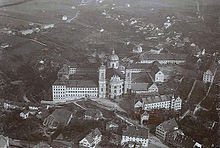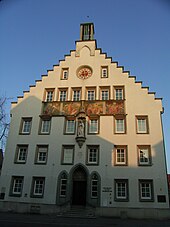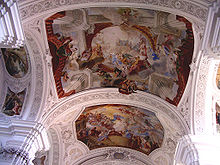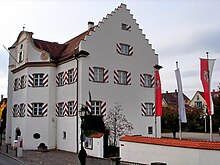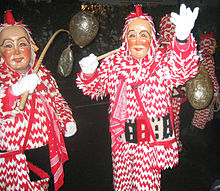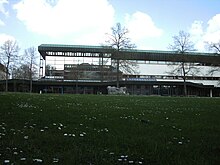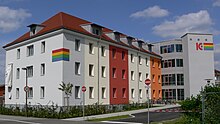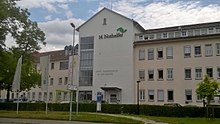Weingarten (Württemberg)
| coat of arms | Germany map | |
|---|---|---|

|
Coordinates: 47 ° 49 ' N , 9 ° 39' E |
|
| Basic data | ||
| State : | Baden-Württemberg | |
| Administrative region : | Tübingen | |
| County : | Ravensburg | |
| Local government association: | Middle Schussental | |
| Height : | 485 m above sea level NHN | |
| Area : | 12.16 km 2 | |
| Residents: | 24,943 (Dec. 31, 2018) | |
| Population density : | 2051 inhabitants per km 2 | |
| Postal code : | 88250 | |
| Area code : | 0751 | |
| License plate : | RV, SLG , ÜB , WG | |
| Community key : | 08 4 36 082 | |
City administration address : |
Kirchstrasse 1 88250 Weingarten |
|
| Website : | ||
| Lord Mayor : | Markus Ewald | |
| Location of the city of Weingarten in the Ravensburg district | ||
Weingarten (until 1865: Altdorf ) is a medium-sized town in the south-east of Baden-Württemberg in Germany .
The city of Weingarten is the third largest city in the Ravensburg district after the neighboring city of Ravensburg and Wangen im Allgäu . Since January 1, 1974 it has been a major district town . It covers an area of 12.16 km² and has 24,943 inhabitants (as of 2018) which corresponds to 2,051.23 inhabitants / km². The origins of the settlement go back to the 5th century. It was shaped for centuries by the Weingarten abbey founded by the Welfs , whose monastery church is one of the largest baroque-style church buildings north of the Alps and houses one of the most important baroque organs in Germany. Weingarten is the seat of a teacher training college and a college for technology, economics and social affairs . The city is also known nationwide as a carnival stronghold and for the Blood Kick , an annual equestrian procession in honor of a Holy Blood relic.
geography
Geographical location
Weingarten is located immediately north of Ravensburg or a few kilometers west of the Altdorf Forest on the eastern edge of the Schussen Basin in the middle valley of the Schussen , which flows into Lake Constance and is thus a right-hand Rhine tributary. The old town, the former village of Altdorf, lies in the valley of the Scherzach , a small stream that flows into the Schussen. The Weingarten monastery, which gives the city its name, is located on the northeastern elevation, the so-called Martinsberg, above the old town.
climate
The average annual rainfall in Weingarten is 854 mm.
Neighboring communities
The following cities and communities border the city of Weingarten. They are named clockwise starting in the north and all belong to the Ravensburg district: Baienfurt , Schlier , Ravensburg and Berg .
City structure
No surrounding communities were incorporated into the city of Weingarten. As a result, the urban area forms a relative unit. Nevertheless, for better orientation, different urban areas with their own names are colloquially differentiated, the names of which have emerged in the course of the development and whose boundaries are usually not precisely defined. In addition, a distinction is made between a few separately located residential areas with their own names, which, however, have very few residents. These include: Bechters, Eggers, Hähnlehof, Hinterochsen, Meisterhof, Nessenreben, Ortliebs, Sterkshof, Trauben, Vorderochsen, Waldheim and Welte.
Spatial planning
Weingarten together with Ravensburg and Friedrichshafen , the regional center of Upper Swabia region . This also takes on the function of a central area for the Ravensburg / Weingarten catchment area . This also includes the southern part of the Ravensburg district, in particular the communities of Baienfurt , Baindt , Berg , Bodnegg , Fronreute , Grünkraut , Horgenzell , Schlier , Vogt , Waldburg , Wilhelmsdorf , Wolfegg and Wolpertswende in addition to Ravensburg and Weingarten .
history
Altdorf
Until 1865 the name Weingarten was only used for the Weingarten monastery , the surrounding village was called Altdorf . The name is derived from the old Germanic cult word alach for "sanctuary, temple", so it was a place with / near a sanctuary.
Altdorf was already settled by Alamanni in the early 5th century (probably under the name Alachdorf) . The Weingarten burial ground dates from the Merovingian period and has been almost completely investigated. The core of the burial ground and the Martinsberg form a west-east axis, which is why it can be assumed that the Alemannic sanctuary was on the Martinsberg. The richness of the finds suggests an Alemannic manor. In the 8th century at the latest, Altdorf became part of the Franconian Empire like the entire Alemannic region . Came around the middle of the 9th century, the average Schussental as county Schussen gau in possession of the Swabian branch of the Guelph (originally francs from the Meuse-Moselle area), one in Altdorf opposite the Martin Berg Palatinate built their new family seat.
In the first third of the 10th century, a Romanesque church was built on what is now the Kreuzbergfriedhof, which was later rebuilt in the Romanesque-Gothic style .
Around 935 the Welfs founded a women's monastery in Altdorf, which was intended as a burial place (family grave) for their sex, but was destroyed by fire in 1053. The nuns were first relocated to the Martinsberg.
In 1056 Welf IV founded a new Benedictine monastery on Martinsberg after the castle was moved to the neighboring Ravensburg , which was populated by monks from Altomünster ; In return, the Altdorf nuns settled in the Altomünster monastery.
In 1094 Judith von Flanders , the wife of Welf IV, gave the Holy Blood relic to the monastery . In addition to the many other donations, the relic received little attention. Not until 1182, when the Romanesque basilica was consecrated, was it specifically mentioned.
Around 1122 Friedrich I. Barbarossa was born perhaps on the Haslachburg in the Lauratal (or in Waiblingen or Hagenau). The name Weingarten Monastery is documented around 1123. The monks were busy u. a. with illumination, her most famous work is the Berthold Sacramentary (1217, now in the Pierpont Morgan Library in New York). A market developed in the town of Altdorf from the 13th century. Under King Rudolf von Habsburg , however, the development of a town was hampered by the establishment of the Upper Swabian bailiff (later the Swabian bailiff ), whose seat was initially in neighboring Ravensburg, but after the “ Veitsburg ” there was destroyed in the Thirty Years' War in 1647, it was relocated to Altdorf. The bailiwick over the village , which was initially directly imperial , was mostly pledged to princes or nobles, including the Reichstruchsessen von Waldburg . In an imperial charter from 1377 Altdorf was granted the right to a regular weekly market, but it was not allowed to endanger existing markets within one mile (7.4 km) - and thus the Ravensburger market. City fortifications were also prohibited. During this time, the neighboring city of Ravensburg, as a free imperial city, attracted numerous residents from Altdorf, including the later Ravensburger merchant families and patrician families Holbein and Humpis .
Construction of the baroque basilica
The Weingarten monastery, on the other hand, was elevated to an imperial abbey in 1274 and over time acquired large land holdings from the Allgäu to western Lake Constance. This property last covered 306 km², so Weingarten was not only one of the richest monasteries in southern Germany, but also ruled larger areas than most imperial cities. Since the Holy Blood relic presented by Judith von Flanders in 1094 attracted more and more pilgrims, the Weingarten Monastery needed a new place of worship. The old Romanesque church was too small. They wanted to replace them in order to give even more pilgrims the chance to admire the Holy Blood relic and to give the precious gift a new, even larger and more splendid place. In addition , as was customary in the Baroque era , the basilica wanted to show its own power to the outside world, and this was impressively achieved with the construction of the basilica. In the baroque era, the prevailing view was that noble descent and efficiency alone did not give a prince any sovereignty or greatness. Hence, grandeur and magnificence give a princely court the greatest appearance and adornment of glory (power). In addition, it gives him greater obedience and deeper respect from his subjects. This was also the reason for the vineyard monks who envisaged a grand renovation of their monastery. But there were also spiritual and religious reasons. For the greater glory of God, the new baroque building was also intended to express the pride of the Weingarten monks in the successful monastery reform. Weingarten had victoriously overcome alienation from the Benedictine Rule , monastic mismanagement, secularization and the challenge of the Reformation . On September 10, 1724, the Prince-Bishop of Constance, Johann Franz Schenk von Stauffenberg, was able to inaugurate the church. The celebrations in Altdorf lasted for 10 days.
But if you compare today's monastery complex with the building plan of that time, it is noticeable that the original plan could not be fully implemented. In the north of the complex, only the palace could be completed under the direction of Franz Schmutzer. But when they wanted to continue building, the Landvogtei filed a complaint with the Innsbruck government, and this initiated a construction freeze. The reason for the notification was that the new building apparently left the monastery area. The costs of building the basilica were also very high, so that the monastery was heavily in debt and had no more money. But the French War and the secularization also made the construction work more difficult. For these reasons, the medieval cloister and buildings in the southern area of the monastery are still preserved today. In the course of secularization, the monastery was dissolved in 1802 and initially owned by the House of Orange-Nassau .
Altdorf itself was part of the Habsburg administrative unit of Upper Austria from 1452 and remained the seat of the Swabian bailiff until 1805 , when the Kingdom of Württemberg came after the Peace of Pressburg and initially became the seat of an upper office. The Weingarten Monastery was also added to his ally Württemberg in 1806 by Napoleon. In 1810 Altdorf and Weingarten came to the Oberamt Ravensburg . Altdorf-Weingarten also lost its position as bailiwick in 1817 as part of a new administrative division.
When the Friedrichshafen – Ravensburg railway line was opened in 1847 and was to be continued northwards in 1849, the mayor Adolf Prielmayer was a vehement opponent of a connection to Altdorf. The traders in particular do not forgive him that the route now runs past the site at a great distance. During the German Revolution of 1848/49, this led to vehement protests by the population against the loyal and conservative Prielmayer .
Vineyard
In 1865 Altdorf received city rights under the then mayor Friedrich Seifriz from King Karl von Württemberg and was renamed Weingarten after the name of the abbey . In 1922 a Benedictine abbey was re-established in part of the monastery buildings.
As in the neighboring town of Ravensburg, a significant mechanical engineering industry developed in Weingarten.
Weingarten received its first barracks in 1868 and became the location of the Württemberg army . Between 1898 and 1918 it was a garrison for the 124th Infantry Regiment , to which the future General Field Marshal Erwin Rommel belonged until 1916.
At the time of National Socialism , Weingarten was incorporated into Ravensburg on April 1, 1939. The rival neighboring towns were separated again after the end of the war, and from April 1, 1946 Weingarten was independent again.
As part of the French occupation zone , Weingarten came to the newly founded state of Württemberg-Hohenzollern in 1947 , which was incorporated into the state of Baden-Württemberg in 1952.
Since 1949, most of the former monastery building has been used for teacher training (Reutlinger Pedagogical Institute, since 1962 as a pedagogical university ). Part of the main building is leased by the diocese of Rottenburg-Stuttgart for the Catholic Academy, an adult education facility, and another part is occupied by the Benedictine monastery.
Efforts to reconnect with Ravensburg during the community reform in the 1970s met with massive resistance from the Weingarten population and were therefore not realized. The population exceeded the limit of 20,000 in 1973; the city administration then applied for a major district town, which the state government of Baden-Württemberg decided with effect from January 1, 1974.
In 2004 the Baden-Württemberg Home Days took place in Weingarten . In connection with this event, the newly designed city garden was inaugurated as part of the city renovation .
In 2007 the city of Weingarten received the Baden-Württemberg City Marketing Prize for the most innovative online idea . The reason for this was the online video library on the city's website, on which the city presents itself with short films about Weingarten. Internet users can watch numerous videos about the Blood Entry , Welfenfest (formerly the school and home festival ) or the Fasnet .
The Baden-Württemberg State Fire Brigade Day was held in 2008 by the fire brigades from Ravensburg and Weingarten.
In September 2009, the Benedictine monastery announced the closure due to concerns about young people. The almost 1000-year history of the monastery comes to an end. On October 16, 2010 the monastery was closed and the monks said goodbye with a service from Weingarten.
Industrialization in Weingarten
Industrialization began in Weingarten in 1866 . The Weingarten flax, hemp and waste spinning mill was built in the Lauratal valley and still bears the name Sontheimer today. Thanks to the nearby Scherzach, it was possible to use steam engines . However, the lack of a connection between Weingarten and the rail network hampered industrialization. The goods were unloaded in Ravensburg or Niederbiegen and had to be picked up by the respective companies. It was only with the construction of the Ravensburg – Weingarten local railway in 1887/88 that the young city got a little out of the traffic shadow.
Population development
Population numbers according to the respective territorial status (until 1861 that is the Altdorf municipality). The figures are census results (¹) or official updates from the respective statistical offices ( main residences only ).
|
|
¹ census result
In the first decades of the 19th century there was initially only a moderate increase in the population. This may be related to the fact that after the secularization of the Benedictine Abbey of Weingarten (1803) and the transition of the former market town of Altdorf in front of Austria to the Kingdom of Württemberg (1806), which was connected with the dissolution of the Landvogtei, former central functions barely held or remained in Altdorf-Weingarten . could develop anew. The community came more and more into the shadow of the up-and-coming, nearby Oberamtsstadt Ravensburg .
In the 1830s and 1840s, however, there was a significant increase in population, which, in addition to an increase in average life expectancy, is attributable to the high birth rates. This upward trend was interrupted in the middle of the century. The cause was a general rise in prices, triggered by a potato disease (1851/52) which occurred across Europe at the time and which led to a wave of emigration even in the Upper Swabian farming region. Towards the end of the 1860s the population increased again significantly, a tendency that continued until the First World War . The main impulses for this above-average growth were the town elevation (1865), the beginning of industrialization (e.g. the founding of the Weingarten machine factory in 1866) and the establishment of a garrison (since 1868).
Religions
The Weingarten Abbey and the village of Altdorf belonged to the Diocese of Constance and were subordinate to the Archdiakonat Allgäu, Landkapitel Ravensburg. A church of St. Maria was incorporated into a nunnery after 934. From 1054 it was also the parish church of Altdorf, but the original church of St. Martin dates back to the 8th or 9th century. In 1279 the church of St. Maria was incorporated into the Weingarten monastery. The Reformation did not find its way, so that Altdorf remained predominantly Catholic until the 19th century. The medieval construction of the parish church of St. Maria was replaced by a new building from 1738 in the 18th century, but was demolished in 1818/19, as the monastery church of Weingarten Abbey had been elevated to parish church since 1811. The community belonged to the Diocese of Constance until 1817, when it was subordinated to the Ordinariat Ellwangen , from which the newly founded Diocese of Rottenburg (today Rottenburg-Stuttgart) emerged in 1821/27 . After the Second World War, two more Catholic parishes and churches emerged, the Church of St. Maria, Hilfe der Christisten (1960) and the Holy Spirit Church from 1977. The three parishes belong to the Allgäu-Oberschwaben deanship of the Rottenburg-Stuttgart diocese . The Schoenstatt Sisters of Mary are also based in Weingarten.
Protestants also moved to Altdorf and Weingarten in the 19th century. In 1825 a Protestant parish was founded, which belongs to the deanery or church district of Ravensburg of the Evangelical Church in Württemberg . In 1883 the community was able to build its own town church. The architect was Christian Friedrich von Leins . Several pastors work in the parish today. Today there is also an administrative office for the Ravensburg church district in Weingarten.
In addition to the two large churches in Weingarten, the Church of Jesus Christ of Latter-day Saints (Mormons) is represented with a congregation and Jehovah's Witnesses with a congregation in Weingarten.
Since the arrival of Russian emigrants after the collapse of the Soviet Union , a not inconsiderable part of whom are Jewish, a modest Jewish community has emerged in Weingarten with around 50 members so far. So far a back room has been used for religious ceremonies, there has been no synagogue in the Schussental since the 15th century.
The following statistics show the development of religious affiliation from 1821 to 1987:
| year | Residents | Catholic | evangelical | other |
|---|---|---|---|---|
| 1821 | 2.234 | 2,205 | 29 | 0 |
| 1900 | 6,443 | 5,358 | 1,078 | 7th |
| 1925 | 7,035 | 5,907 | 1,098 | 30th |
| 1950 | 11,585 | 9,451 | 2,277 | 130 |
| 1987 | 20,918 | 14,572 | 4,296 | 2,050 |
politics
Administrative association
The city of Weingarten is a member of the Mittleres Schussental community administration association .
Municipal council
The local elections on May 26, 2019 led to the following result:
|
Weingarten municipal council election 2019
Turnout: 52.49% (2009: 41.8%)
% 30th 20th 10
0
21.28%
26.17%
29.13%
12.9%
9.56%
n. k.
Gains and losses
|
Youth Council
In 1985, Germany's first youth community council (JGR) was founded in Weingarten . The Weingarten municipal youth council as an opportunity for young people to participate politically set a course nationwide. The then mayor, Rolf Gerich, played a key role in its creation . The school with the most students gets the most seats on the youth council. Elections take place at the Weingarten schools every year.
(Lord) Mayor
Until the 19th century Altdorf had only limited self-government and no representation of the citizens. At the top was Ammann, who was appointed by the abbey, but the citizens of Altdorf could participate in his election. The judicial power lay with the Ammann or with the abbey ( lower jurisdiction ) and with the governor ( high jurisdiction ). During the Württemberg period, the mayor, later mayor, then headed the municipal administration, and there was also a council.
- 1789–1810: Sebastian Schafheitlin
- 1810–1819: Franz Gerth
- 1819–1826: Sebastian Matt
- 1826–1842: Georg Josef Rugel
- 1842–1855: Konrad Prielmayer
- 1855–1889: Friedrich Seifriz
- 1889–1904: Karl Egger
- 1905–1920: Josef Reich
- 1920–1937: Wilhelm Braun
- 1937–1945: forcibly incorporated into Ravensburg
- 1945–1954: Wilhelm Braun
- 1954–1975: Richard Mayer (Mayor from 1974)
- 1975–1992: Rolf Gerich
- 1992-2008: Gerd Gerber
- since 2008: Markus Ewald
coat of arms
Description of the coat of arms : Square with a heart shield, in it a natural vine in gold on a green three-hill.
- Field 1: in red a silver lion turned to the left, holding a golden shield with the black double eagle in its front paws.
- Field 2: in silver a red lion holding a red shield with a silver bar in its front paws
- Field 3: in silver a red lion turned to the left
- Field 4: a silver lion in red
The coat of arms (without the heart shield) was awarded to Altdorf in 1555. The lions refer to the Guelphs, the black double-headed eagle to the Holy Roman Empire, the colors and the red shield with a silver bar to belonging to Upper Austria. Altdorf's coat of arms contained no reference to Weingarten monastery.
With the elevation to the city and the renaming to Weingarten , the heart shield was added to the coat of arms in 1865, which shows a speaking coat of arms from the coat of arms of the Reichsabbey Weingarten: a vine, the coils of which result in the shape of an abbot's staff (see also coat of arms of Unterwaldhausen ).
Town twinning
Weingarten maintains a city partnership with six cities :
- Burgeis ( municipality of Mals / Italy ), since 1959
- Bron ( France ), since 1963
- Blumenau ( Brazil ), since the 1970s
- Brest ( Belarus ), since 1989 with the community administration association Mittleres Schussental, to which Weingarten also belongs
- Grimma ( Germany ), since 1990
- Mantua ( Italy ), since 1998
Culture and sights
Buildings
The basilica of St. Martin is the symbol of the city. It was built as the monastery church of Weingarten Abbey and is considered to be the largest baroque church north of the Alps with about half the length of St. Peter's Basilica in Rome . As a nickname she carries u. a. therefore "Swabian St. Peter". The planned by Caspar Moosbrugger and by Franz Beer u. a. The church that was built is still a testimony to the power and wealth of the once imperial Benedictine abbey. The rich furnishings include frescoes by Cosmas Damian Asam , stucco work and the choir stalls by Joseph Anton Feuchtmayer . The great organ by Joseph Gabler (1750) is considered to be one of the most important baroque organs in Germany and was restored from 1981 to 1983. The title of a minor basilica was given to the minster in 1956 by Pope Pius XII. awarded. Numerous strictly protected bats live in the roof structure.
The surrounding baroque monastery buildings are used by the Benedictine abbey Weingarten (until 2010), the college of education and the academy of the Diocese of Rottenburg-Stuttgart. The university buildings are largely accessible, the abbey and its medieval cloister can only rarely be visited as part of special exhibitions and guided tours. The baroque fruit box (granary) of the monastery from 1688 has been the seat of the library of the Pedagogical University since 1972 and also the seat of the library of the Ravensburg-Weingarten University since 1986 . The courtyards of the monastery complex were used in summer for open-air performances of the monastery festival. In 2016, however, the festival location was moved to Nessenreben.
The needs of the monastery (water supply, water power, etc.) - and the motto of St. Benedikt's “ Ora et labora ” (“Pray and work”) - the city owes the Silent Bach , one of the oldest canal systems in Germany.
The "Schlössle" was built in the Renaissance style around 1550 as the administrative seat of the Upper Austrian Landvogtei Swabia . In the 18th century it was the residence of the imperial district judges (rich baroque stucco work by Franz Schmuzer dates from this time ), in the 19th and early 20th centuries it served as a residential building for officers. The city museum has been housed in the Schlössle since 2001 and presents the history of the city and the monastery. Temporary exhibitions take place in the attic, and until 2011 the courtyard was used for theater performances at the monastery festival in the summer .
The neo-Gothic Evangelical City Church Weingarten was inaugurated in 1883.
Castle ruins
Traces of old castles can still be found in Weingarten. In the Lauratal valley there are still remains of Wildeneck Castle and a memorial stone from Haslachburg , on which Emperor Friedrich Barbarossa was supposedly born. Other castles are suspected on the Martinsberg, on which the basilica is located today, and on the Hallersberg the Welfenburg.
Museums
- The city museum in the Schlössle has been showing the history of the city of Weingarten since 2001, from the Guelphs to the Altdorf area to the farmers' war with the Weingarten contract. The local history museum is in the former building of the administrative headquarters of the Upper Austrian Bailiwick of Swabia , the so-called Schlössle.
- The Alemanni Museum Weingarten in the former grain house houses the rich archaeological finds from the early medieval burial ground of Weingarten and is one of the largest special museums on the history of the Alemanni .
- The carnival museum of the Plätzlerzunft shows over 50 life-size figures and many other objects and documents on the history of the Swabian-Alemannic carnival in Weingarten.
- The Museum for Monastery Culture shows monastery costumes, devotional figures and other objects of Catholic popular piety from the Jürgen Hohl collection in seven rooms .
Pilgrimage
The historic Jakobspilgerweg , which ends in Santiago de Compostela , Spain , leads through the Weingarten Monastery . The monastery is located on the Upper Swabian Way of St. James from Ulm to Constance. A metal plaque at the northern entrance to the church shows the way: 2400 km to Santiago. Today, many people visit Weingarten again on foot and by bike on this long-distance hiking trail .
← Previous location: Bad Waldsee or Bergatreute | Weingarten (Württemberg) | Next place: Ravensburg →
Regular events
Carnival
The Swabian-Alemannic carnival may have been a tradition in Weingarten since 1348, when town hall dances are said to have taken place after a plague epidemic . This ancient tradition is maintained primarily by the Plätzlerzunft Altdorf-Weingarten 1348 e. V. In addition, the fools' associations Bockstall and Wikinger have existed since the 1980s . After closing in on Epiphany (January 6th) and dusting the masks on the Friday after Epiphany, the main carnival begins on the evening before Gumpigen Thursday with the “fountain cleaning speech”. On Gumpigen Thursday, the main day of the Swabian-Alemannic carnival, the carnival is announced early in the morning, the students are freed from their yoke, the mayor deposed and a foolish citizens' meeting is held. After a children's parade, the fool's tree is pulled through the city and placed on the Münsterplatz. Immediately afterwards the oldest custom of this city follows: the town hall dance, which is said to go back to the year 1348. This year a terrible bubonic plague ended in Upper Swabia and the survivors are said to have danced for joy around the town hall fountain. The day ends with the shirt- bell parade, a noisy parade in which anyone in pajamas or nightgown can jump through the city center, shouting and making noise.
The old people's home is visited on Bromigen Friday and the “stingy call” is maintained by the goat jesters. The big fool's jump traditionally takes place on Carnival Sunday with around 5000 participants. In addition to the Weingartner fool figures such as the Plätzler , the Lauratalgeistern or the Schlößlenarren , there are also many foreign guilds from the Swabian-Alemannic Fasnet area. The “Most Club Meeting” takes place on Carnival Monday in the traditional “Ochsen” bar. Local but also political events in the city are pilloried there. On carnival Tuesday an old Heischebrauch is maintained with the pretzel throwing in the city before evening after religious ceremony, the carnival is burned under the tears of the funeral association loudmouth on the Cathedral Square. The fools tree is felled on Ash Wednesday at 5:30 a.m. , and in the evening the fools receive the ash donation in the Weingarten basilica. The following Saturday the circle closes with the spark ring dice in the guild house.
In 1990, 1998, 2006 and 2015 the Plätzlerzunft organized the landscape meeting of the region Oberschwaben-Allgäu. The Südwestrundfunk transferred in 2006 and 2015, the large Narrensprung live on television .
Blood kick
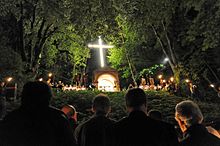
On the Friday after Ascension Day , the Blood Admission takes place, the largest horsemen's procession in the world in honor of a relic which , according to legend, contains earth soaked with drops of blood from Jesus Christ . This drop of blood is said to have been caught by a Roman legionnaire who later came to be known as Saint Longinus . The relic came to Mantua with his bones . From there came part of the relic about Emperor Heinrich III. , Count Baldwin V of Flanders and his daughter, stepdaughter or half-sister (depending on the source) Judith to the Guelphs and finally to Weingarten. The relic is carried by the Holy Blood rider , who donates the blessing of the Holy Blood for the house, yard and fields.
The blood kick was first mentioned in writing in 1529 and was already called a custom "from ancient times". At the beginning of the blood step, thousands of pilgrims take part in an evening light procession to the Kreuzberg (since 1890) on Ascension Day . On Blood Friday , the blood kick begins at around 7:00 a.m., in which around 3,000 riders in tails and top hats and numerous music bands take part. The bloodstream is followed on the streets of the city by around 30,000 pilgrims and spectators. The film Die Blutritter (2004) by Douglas Wolfsperger shows participants and pilgrims at the blood kick and their lives in the region.
Welfenfest
The “school and home festival” began around 1750 as a school excursion (the so-called school day ). The students went from house to house, begging for gifts and consuming them while playing and singing on site. In 2011 the name of the festival was changed to "Welfenfest Weingarten". Today the Welfenfest is a large folk festival with tens of thousands of visitors. It starts three weeks before the summer vacation and lasts five days.
The highlights of the festival are:
- the citizens' meeting and the handing over of the flags by the Weingarten city chief to the school drummers, the school drummers, the high school drummers and the fanfare procession on the Welfenfest Friday
- the day of meeting foreign citizens on the Welfenfest Saturday
- the home evening in the culture and congress center; a gala evening by citizens for citizens from Weingarten, also on the Welfenfest Saturday.
- the Welfentheater with pupils from the city of Weingarten and the students from the University of Education. In 2013 and 2014 the Laurasage was staged and performed.
- the historical pageant on Welfenfest Monday, which is traditionally divided into a colorful and a historical part. Around 2000 children and young people, 20 music bands and groups of drummers as well as around 40 mostly horse-drawn floats take part in the parade. The audience gets an insight into the city and monastery history from the settlement by the Alamanni to the vineyards of the present.
The various events are accompanied by the hustle and bustle on the fairground , which culminates in the fireworks on Monday evening.
Monastery Festival
Even before the monastery festival began in 2000, there were theater performances on the Martinsberg. Only in 2000 this tradition was resumed by the town of Weingarten and the monastery. Since this year, some major plays have been the focus of this monastery festival. Until 2016, the performances took place in the courtyard of the monastery complex, since 2016 the festival location has been relocated to Hofgut Nessenreben.
- 2000/2001: Everyone - Hugo von Hoffmannsthal
- 2002: Antigone - Jean Anouilh
- 2003: The Miser - Molière
- 2004: Romeo and Juliet - William Shakespeare
- 2005: The Maid of Orleans - Friedrich Schiller and The Emigrants - Uli Boettcher & Brian Lausund
- 2006: A Midsummer Night's Dream - William Shakespeare and The Egg is Hard - Loriot's Delicacies - Vicco Bülow
- 2007: Nathan the Wise - Gotthold Ephraim Lessing and Sonny Boys - Neil Simon
- 2008: Faust - The Tragedy First Part - Goethe and The Marriage - Nikolai Gogol
- 2009: The broken jug - Heinrich von Kleist and Ritter Unkenstein - Karl Valentin
- 2010: Cabal and love - Friedrich Schiller and snoopers, sex and beautiful women - Tony Dunham
- 2011: What you want - William Shakespeare and Mirandolina - Carlo Goldoni
- 2012: The physicists - Friedrich Dürrenmatt
- 2013: The Captain of Köpenick - Carl Zuckmayer
- 2014: Amadeus - Christof Küster and Tom Sawyer and Huckleberry Finn - production by Nadine Klante
- 2016: Life of Galilei - Bertolt Brecht and master detective Kalle Blomquist - Astrid Lindgren
City festival
The city festival always takes place in Weingarten on the last weekend in August. The local clubs are responsible for hosting the festival. Live bands play on various stages in the city center. There is a large flea market on both days and the children's flea market in the city garden on Saturday. The festival is opened by the mayor of the city and the chairman of the city festival committee with the tapping of the keg .
Kite Festival in Nessenreben
Every year on the first weekend in October the kite festival takes place on the former military training area Nessenreben , which attracts thousands of visitors. On the large lawn, visitors can fly their kites or take part in various other activities such as archery or face painting. The highlight is a hot air balloon launch with several hot air balloons.
other events
- Inner courtyard festival, an open air festival that has been held in the inner courtyard of the monastery at the end of June for around 20 years.
- Herbstschau , the exhibition of local companies and associations, has taken place every year in September or October since 2004. In 2016, the event was held together with Baienfurt on the site of the former Stora Enso paper mill under the name “Falkenhorst”.
- International Weingarten Days for New Music , music festival in autumn (1986 to 2016)
- May festival, every 2 years the May festival takes place on the Münsterplatz on the night of May 1st. This is managed by the Gerwerbe- und Handelsverein Weingarten e. V. organized.
One-time events
In 1993, the publishing house organized Ravensburger the memory -Europameisterschaften in Weingarten. In 1998, 2006 and 2015, the Plätzler guild organized the VSAN -Landschaftstreffen of the Oberschwaben-Allgäu region, where in 2015 the 1st Plätzler World Cup was held at the speed of a Karbach . In 2004 the Heimattage Baden-Württemberg took place in Weingarten. Weingarten was a stage destination of the Tour de Ländle in 2006 and 2015. The Baden-Württemberg State Youth Fire Brigade Day took place in Weingarten in 1992. The fire brigades from Ravensburg and Weingarten organized the Baden-Württemberg State Fire Brigade Day in 2008 . From 17th to 18th In July 2009 the open-air festival “Classic Rock Night” took place in the Ermlandhof Weingarten . The Manfred Mann's Earth Band , The Sweet , Smokie , The Rattles and Middle of the Road were guests.
Sports
There are numerous sports clubs in Weingarten, including the trampoline jumpers from TV Weingarten, who jump in the 1st Bundesliga. The women's handball team of TV Weingarten plays in the Baden-Württemberg Oberliga, the soccer club SV Weingarten in the state league . The water polo players of the Weingarten swimming club play in the association league in the 2011/2012 season, the women's basketball team of the TV Weingarten Lions in the national league.
Together with volunteers, the Weingarten cycling association is taking care of a bike facility (built in 2007), a flow trail (built in 2014) and a pump track (opened in 2018) in the area of the former military training area and local recreation area Nessenreben. The three facilities have been combined under the name " Bikepark Weingarten" since April 2018 .
Economy and Infrastructure
traffic
Streets
Weingarten is on federal highways 30 and 32 . The next motorway access is at Ulm ( A 8 ) and Wangen im Allgäu ( A 96 ), as well as at Stockach ( A 98 ).
railroad
The Niederbiegen – Weingarten railway line existed until 1998 , most recently with pilgrims to the basilica or in charter traffic.
Weingarten is on the Württemberg Southern Railway . Long-distance trains as well as Interregio-Express and Regional-Express trains do not stop here, but in Ravensburg, approx. 3 km away .
The Weingarten stop has been served by the Bodensee-Oberschwaben-Bahn every hour since May 24, 1998 under the name Weingarten / Berg .
Tram Ravensburg – Weingarten – Baienfurt ( Bähnle )
In 1888 a 4.2 km long steam-powered tram line (gauge 1000 mm) was opened between Ravensburg and Weingarten, which was electrified in 1910. In 1911 there was a 2.4 km extension to Baienfurt . On February 23, 1959, the Ravensburg – Weingarten line was closed, and the remaining line from Weingarten – Baienfurt followed in June 1959.
Other local transport
In addition to the Bodensee-Oberschwaben-Bahn, city buses (city traffic Ravensburg-Weingarten) and regional buses run in Weingarten. Weingarten belongs to the Bodensee-Oberschwaben transport association ( bodo ).
Established businesses
The CHG-Meridian AG is one of Europe's largest leasing -Unternehmen in the field of information technology . The company was founded in 1979 in the neighboring municipality of Berg and has had its headquarters in Weingarten since 2003.
The printing house Ulm – Oberschwaben prints several issues of the regional daily newspaper Schwäbische Zeitung , the regional weekly newspaper Südfinder , the Wochenblatt and various official journals with smaller editions. A total of 100 employees are employed there producing around 2 million newspaper copies per week.
The Kunstverlag Weingarten (a subsidiary of the Athesia publishing calendar ) is nationally and internationally a leading provider of image calendars.
The BRIEF Ravensburg branch of Deutsche Post AG is based in Weingarten and operates the mail center for Postleitregion 88. This branch also manages Postleitregion 89, the mail center in Neu-Ulm and the parcel center in Günzburg.
For a long time the most important company in Weingarten was the mechanical engineering company Müller Weingarten . This name was abandoned in 2011; the company has now been integrated into the Schuler mechanical engineering group. The site, also known as the “Schuler site”, was sold to an investing company in 2016. A new residential area under the name "Martinshöfe" is to be built there by 2023.
media
- Through the local events in Weingarten reported as a daily newspaper , the Swabian newspaper , which operates a local newsroom in Ravensburg. Regio TV Bodensee can be received as a regional television station, Radio 7 can be received as a local radio station.
- The Bürgerzeitung Weingarten im Blick has been distributed to all households in Weingarten since October 30, 2009 and is the official gazette of the city of Weingarten as well as a citizen newspaper from citizens for citizens.
- On the city's own online portal Welfenmarkt , stationary shops offer their goods as well as craftsmen, service providers and the catering industry. In addition, all events in the city can be viewed on the site.
Authorities
Weingarten is the seat of the Ravensburg tax office and the Bodensee-Oberschwaben Chamber of Commerce and Industry. In addition, because of its proximity to Ravensburg , the city has no supra-communal official institutions.
fire Department
The Weingarten volunteer fire brigade consists of around 70 members. It includes a youth fire brigade with 20 members, an age department with 26 members as well as a height rescue group and a leadership group. In 1982 the fire brigade moved to a new fire station . On average, the fire brigade has around 225 missions a year. The youth fire brigade, founded in 1979, is the oldest in the Ravensburg district. As a base, the fire brigade is responsible for the 8 communities Schlier , Vogt , Waldburg , Baindt , Baienfurt , Berg , Fronreute and Wolpertswende with a total population of approx. 60,000; there is close cooperation with the fire services of the respective community.
Educational institutions
Universities and technical schools
There are two universities in Weingarten. The Ravensburg-Weingarten University of Applied Sciences and the Weingarten University of Education form the largest school facilities in the city, each with around 3,000 students. There is also the Academy of the Diocese of Rottenburg-Stuttgart , the Religious Education Institute and the State Seminar for Didactics and Teacher Training for Vocational Schools and Gymnasiums.
The Bodensee – Oberschwaben Health Academy is also located in Weingarten , a joint venture between the Oberschwabenklinik and the Friedrichshafen Clinic , which offers basic , advanced and advanced training in health professions . Training is provided in cooperation with the Ravensburger St. Elisabethen Hospital , the Friedrichshafen Clinic and the Waldburg-Zeil Clinic Tettnang in the professions of health and nursing , health and pediatric nursing and surgical assistant .
schools
Weingarten has a grammar school , a secondary school , a secondary school (valley school) and a special school . There are two primary schools (Schule am Martinsberg and Talschule), of which the school on Martinsberg is divided into two locations (Oberstadt and Promenade), whereby the Promenade location will be closed in 2018.
The Physically Disabled Center Oberschwaben Foundation is the sponsor of a special school for physically and mentally disabled people with a school kindergarten for children with physical disabilities. The school for the physically handicapped comprises the special needs, secondary and secondary schools.
Social facilities
The Foundation for the Physically Disabled Center Oberschwaben (KBZO) was established in 1968 by a parents' initiative. It comprises a private home special school for the physically handicapped as well as a differentiated housing offer for adult physically handicapped persons. She is also a partner in “KBZO Service & Dienst gGmbH”, the interdisciplinary early intervention center “Mobile” and the “Integrative Workshop Oberschwaben”.
There is also a social station of the Ziegler institutions .
The history of the former city-owned hospital 14 Nothelfer goes back to the year 1474. In 2007 the company was transferred to the Krankenhaus 14 Nothelfer GmbH. In spring 2012, due to years of mismanagement and serious negligence by the mayor, the city administration and the supervisory board, the company was on the verge of bankruptcy, which could only be averted by a letter of comfort from the city of Weingarten. In autumn 2013 the hospital company had to be sold; the city of Weingarten remained in liabilities of 17.3 million euros; From the sale of the hospital building and the repurchase obligation entered into, the city faces further multi-million dollar payment risks.
garrison
The history of the Weingarten garrison, which existed between 1868 and 1997, ended after the departure of the last Bundeswehr unit , the Fernspählehrkompanie 200 . There were two barracks in Weingarten, the Argonne barracks and the Welfen barracks . The latter was occupied as Quartier Gallifet by the Forces françaises en Allemagne of the French Army until 1976 .
Personalities
Honorary citizen
The city of Weingarten has given the following people honorary citizenship.
- 1954: Wilhelm Braun , Mayor of Weingarten († 1971)
- 1970: Sigismond Brissy, Mayor of Bron
- 1970: Claudius Viard, President of the “Amitiés Européennes” Bron
- 1970: Alphonse Jung, Bron
- 1975: Richard Mayer, Lord Mayor of Weingarten († 1975)
- 1983: André Sousi, Mayor of Bron († May 4, 2012)
- 1992: Rolf Gerich , Lord Mayor
- 1993: Robert Tournier , 1st alderman of the twin town Bron († 2014)
- 1999: Dieter Müller, Mayor of Weingarten
- 2000: Charles Reydellet, Bron alderman
- 2008: Annie Guillemot, Mayor of Bron
- 2009: Gerd Gerber , Lord Mayor
- 2019: Mathilde Cart-Grandjean, chairwoman of the Broner partnership association "Amitiés Européennes"
These Weingarten citizens became honorary citizens of the twin town Bron :
- 1967: Richard Mayer, Mayor
- 1973: Horst Bögelein, parliamentary group leader
- 1973: Siegfried Börner, parliamentary group leader
- 1973: Hans Werz, parliamentary group leader
- 1983: Dieter Müller, mayor
- 1983: Rolf Gerich, Lord Mayor
- 2001: Gerd Gerber, Lord Mayor
Citizen Medals
Since 2011, the city of Weingarten has awarded the citizen's medal to personalities who have made a special contribution to the well-being of the city. The citizen's medal made in silver shows the vineyards of Weingarten. It is applied to a piece of copper sheet on the roof of the basilica.
- 2011: Sepp Grimm
- 2012: Eugen Klotz
- 2013: Peter Wolff
- 2013: Iris Herzogenrath
- 2014: Dietmar Schillig
- 2014: Kurt Rief
- 2015: Horst Bögelein
- 2015: Ida Jobe
- 2016: Wolfgang Marcus
- 2016: Helgard Fischer
- 2017: Rolf Wilhelm
- 2018: Hans-Ulrich Rudolf
- 2020: Jürgen Hohl
sons and daughters of the town
- Friedrich I. Barbarossa (around 1122 in Weingarten or Waiblingen ), King and Emperor of the Holy Roman Empire
- Jacob Reiner (1555 / 59–1606), composer
- Christoph Spieß (1558–1610), Dept.
- Urban Mayer (1575–1613), Dept.
- Fidel Sporer (1731–1811), sculptor (basilica pulpit)
- Konrad Huber (1752–1830), painter
- Joseph Joachim von Schnizer (1792–1870), artist and politician
- Franz Joseph Sauterfolk (1793–1843), glass painter
- Theodor Sproesser (1870–1933), major general in the Reichswehr
- Franz Egger (1882–1945), Roman Catholic pastor and victim of National Socialism
- Erwin Albert Schmid (1895–1962), painter
- M. Fructuosa (Maria) Gerstmayer (born February 4, 1898 in Weingarten, † September 16, 1952 in Oksadok Prison , North Korea ), benedictine missionary , martyr of Tokwon
- Konrad Schmid-Meil (1909–1969), painter, artist and mayor of Feldkirchen
- Konrad Honold (1918–2007), painter, heraldist and restorer
- Franz Beyer (1922–2018), musicologist, conductor, violinist and violist
- Theo Nikolaus Götz (1930–2008), politician (CDU), member of the state parliament of Baden-Württemberg
- Bernd Wiedmann (1942–2009), lawyer and local politician (CDU)
- Peter Renz (* 1946), writer
- Ursula Voss (1947–2014), dramaturge
- Ruth Wetzel-Steinwedel (* 1948), lawyer, Vice President of the Federal Social Court
- Karin Fransson (* 1951), Sweden's Chef of the Year 2008
- Mario Reis (* 1953), visual artist
- Thomas Ertelt (* 1955), musicologist
- Cornelia Köndgen (* 1958), German-Austrian actress
- Christoph Theinert (* 1959), cellist and composer
- Harald Hillebrecht (* 1960), chemist
- Guido Wolf (* 1961), politician (CDU), 2011–2015 President of the State Parliament of Baden-Württemberg , since 2016 Minister for Justice and Europe
- Reiner Schuhenn (* 1962), church musician, conductor and university professor
- Markus Theinert (* 1964), tuba player and conductor
- Norbert Gälle (* 1964), composer, musician and heating engineer
- Uli Boettcher (* 1966), actor and cabaret artist
- Annemarie C. Mayer (* 1967), Roman Catholic theologian and university professor
- Daniel Ohlmann (* 1973), opera singer (tenor)
- Andreas Beck (* 1986), tennis player
- Benjamin Strasser (* 1987), politician (FDP), Member of the Bundestag
- Clemens Rapp (* 1989), swimmer
- Laura Süßemilch (* 1997), cyclist
- Julia Sauter (* 1997), figure skater (starts for Romania)
People connected to the city
- Duke Welf IV (around 1030 / 40–1101), founder of the monastery
- Duchess Judith of Flanders (around 1030-1094), donor of the Holy Blood relic and wife of Welf IV.
- Abbot Sebastian Hyller (1667–1730), builder of the basilica
- Cosmas Damian Asam (1686–1739), painted the frescoes in the basilica
- Joseph Gabler (1700–1771), creator of the famous organ in the basilica
- Wenceslaus Mattes (1815–1886), Catholic clergyman, university professor and politician
- Karl Lichtenstein (1816–1866), Catholic pastor and dean
- Heinrich Schatz (1846–1914), founder of the Weingarten machine factory
- Adolf Gröber (1854–1919), lawyer and politician (center), grew up in Weingarten and is buried there
- Erwin Rommel (1891–1944), Field Marshal General, joined the infantry regiment "King Wilhelm I" (6th Württembergisches) No. 124 stationed in Weingarten as a flag junior , was appointed lieutenant and trained there until 1912.
- Maria Müller-Gögler (1900–1987), writer
- Tilo Schabert (* 1942), Professor of Political Science, grew up in Weingarten
- Jürgen Hohl (* 1944), local historian and restorer
- Douglas Wolfsperger (* 1957), film director, attended the Weingarten monastery school from 1968 to 1972 and later made a documentary about the Weingartener blood kick
- Axel Müller (* 1963), politician (CDU), member of the Bundestag, lives in Weingarten
literature
- Rudolf Fesseler: History and stories in and around Altdorf-Weingarten . Oberschwäb. Verl.-Anst. Drexler, Ravensburg 1996, ISBN 3-926891-13-0 .
- Werner Heinz: Altdorf / Weingarten, 1805–1945: Industrialization, the world of work and political culture (German edition) . W. Eppe, ISBN 3-89089-018-0 .
- Norbert Kruse , Hans Ulrich Rudolf , Dietmar Schillig, Edgar Walter on behalf of the city of Weingarten (ed.): Weingarten from its beginnings to the present . Biberacher Verlagsdruckerei, Biberach an der Riss 1992, ISBN 3-924489-61-0 .
- Norbert Kruse, Hans Ulrich Rudolf (ed.): 900 years of adoration of the Holy Blood in Weingarten 1094–1994 . Thorbecke, Sigmaringen 1997, ISBN 3-7995-0398-6 .
- Jürgen Hohl : Swabian-Alemannic Carnival in Altdorf-Weingarten . Chroniken-Verlag, Allensbach 1974.
- Johann Daniel Georg von Memminger : Altdorf community . In: Description of the Oberamt Ravensburg. Cotta, Stuttgart and Tübingen 1836 ( full text at Wikisource ).
- Lutz Dietrich Herbst: The silent brook. Benedictine water management between Schlier and Weingarten. In: Newsletter of the Preservation of Monuments in Baden-Württemberg , Volume 47 (2018), Issue 3, pp. 200–205 (PDF; 9.8 MB).
Web links
- Website of the city of Weingarten
- Vineyard at a wide angle of 110 °. A megapixel panorama from Baienfurt to Ravensburg Nord to zoom in down to the last detail (2012).
Individual evidence
- ↑ State Statistical Office Baden-Württemberg - Population by nationality and gender on December 31, 2018 (CSV file) ( help on this ).
- ^ Population, area and population density - State Statistical Office Baden-Württemberg. Retrieved June 10, 2019 .
- ↑ Norbert Kruse (ed.): Weingarten . 1992. ISBN 3-924489-61-0 . Pp. 86–87 (The name Altdorf)
- ↑ Norbert Kruse (ed.): Weingarten . 1992. ISBN 3-924489-61-0 . P. 86
- ↑ J. Fleckenstein: About the origin of the Guelphs . Pp. 105-107
- ↑ Erhard Nietzschmann: The free in the country. Former German imperial villages and their coats of arms. Melchior, Wolfenbüttel 2013, ISBN 978-3-944289-16-8 , p. 9.
- ^ Revolution in the southwest - sites of the democracy movement 1848/49 in Baden-Württemberg. Published by the working group of full-time archivists in the Baden-Württemberg City Council. 2nd Edition. Info Verlag, Karlsruhe 1998, ISBN 3-88190-219-8 , pp. 709 and 710
- ^ Massener vigilante guard on a historical mission . In: Südkurier of April 24, 2015
- ↑ History ( Memento from March 7, 2017 in the Internet Archive ), University of Education Weingarten, accessed on March 7, 2017
- ↑ Weingarten Monastery: "I have tears" . SWR.de. October 5, 2009. Retrieved May 2, 2010.
- ^ Norbert Kruse: Weingarten from the beginning to the present . Biberacher Verlagsdruckerei, Biberach 1992, ISBN 3-924489-61-0
- ↑ City council election 2019 Weingarten. Retrieved May 30, 2019 .
- ↑ Bat protection
- ↑ 1997 - 1984> University> University of Ravensburg-Weingarten. Retrieved January 5, 2019 .
- ↑ http://fasnetsmuseum.de/
- ^ Cyclists' Association Weingarten: ArchivMB. (No longer available online.) Archived from the original on August 10, 2015 ; Retrieved May 19, 2017 . Info: The archive link was inserted automatically and has not yet been checked. Please check the original and archive link according to the instructions and then remove this notice.
- ↑ Origin. Flowtrail Weingarten, April 12, 2014, accessed on May 19, 2017 .
- ↑ a b MTB / DH. (No longer available online.) Weingarten Cyclists Association, November 15, 2016, archived from the original on September 4, 2015 ; Retrieved May 19, 2017 . Info: The archive link was inserted automatically and has not yet been checked. Please check the original and archive link according to the instructions and then remove this notice.
- ↑ Bikepark Weingarten. Retrieved October 2, 2018 .
- ↑ Nicolai Kapitz: Schuler sold area of Lindauer investor. Retrieved July 8, 2020 .
- ↑ Experience Weingarten. Retrieved November 12, 2019 .
- ↑ www.weingarten-online.de
- ^ City of Weingarten: Citizen's Medal . In: www.weingarten-online.de. Retrieved August 17, 2016 .
- ↑ Paul Beck: Sauter people, Joseph . In: Allgemeine Deutsche Biographie (ADB). Volume 30, Duncker & Humblot, Leipzig 1890, pp. 770-772.
- ↑ The Martyrs of Tokwon, Sister M. Fructuosa (Maria) Gerstmayer ( Memento of the original from December 24, 2015 in the Internet Archive ) Info: The archive link was automatically inserted and not yet checked. Please check the original and archive link according to the instructions and then remove this notice. - ( Missionary Benedictines )
- ^ Staatstheater Oldenburg ( Memento from December 14, 2013 in the Internet Archive ), accessed on December 14, 2013







